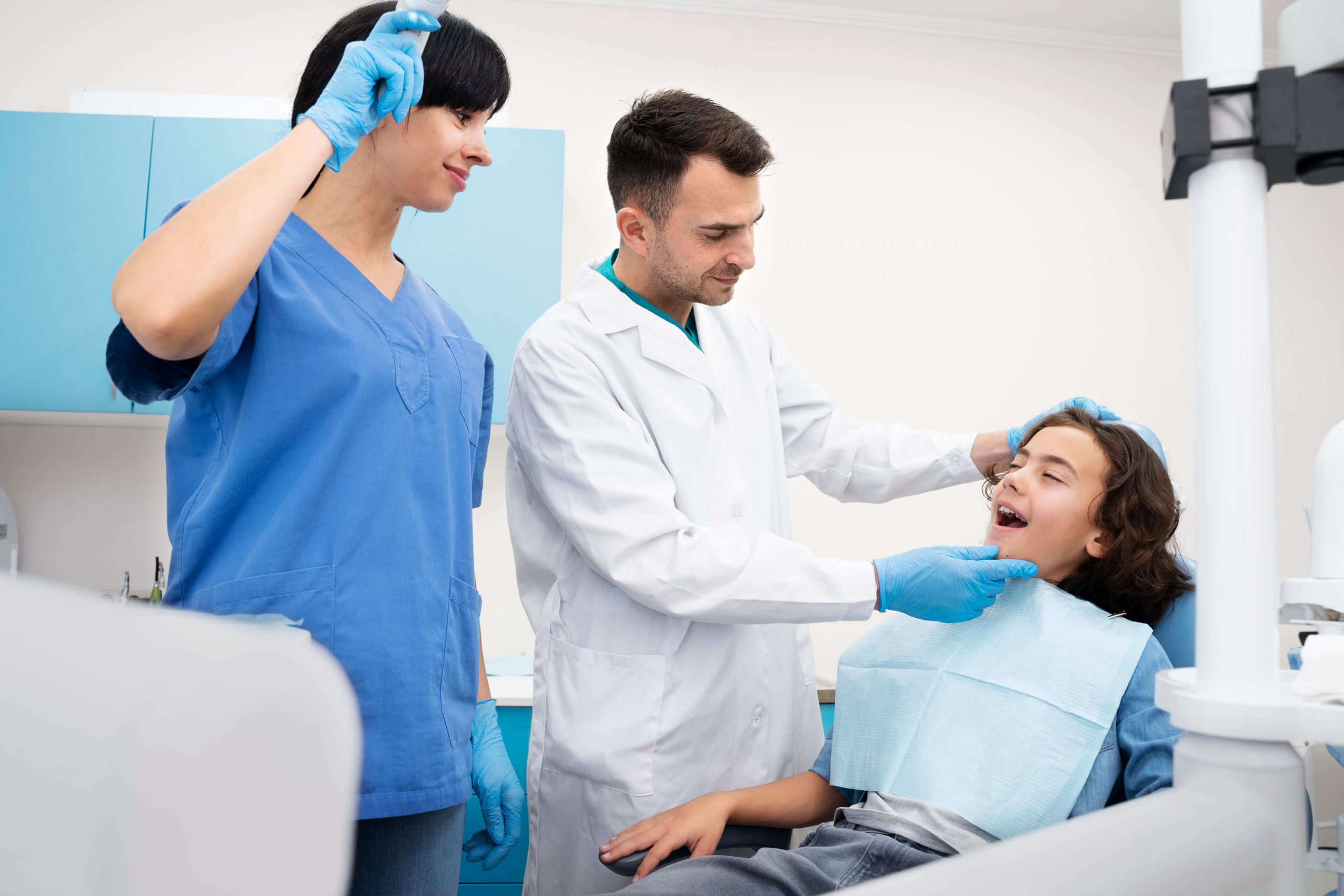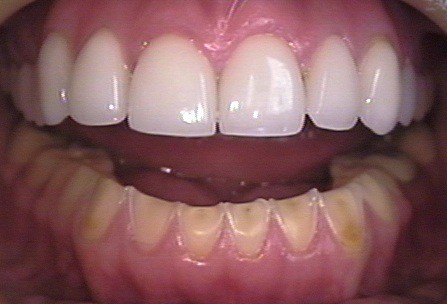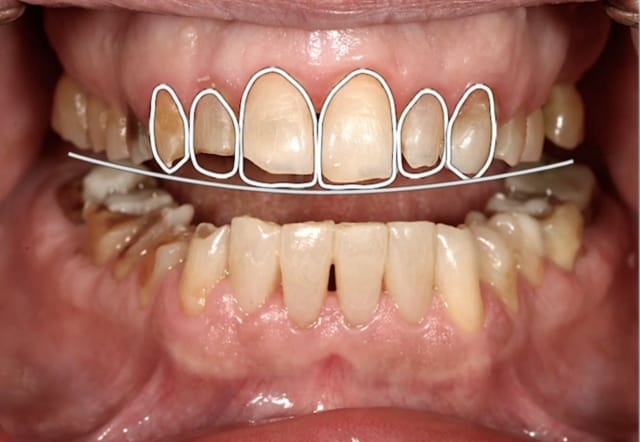
What is the Root Cause of Teeth Wear?
The leading cause of tooth wear is clenching teeth at night time during sleep. People sometimes clench teeth during the daytime hours. But why do people clench their teeth? Bad bites that are not balances. Clenching teeth is known to be a symptom of sleep apnea and UARS.
Normal aging of human body usually involves wear and tear of human cells and tissues. When we eat, grind, chew and bite with the set of our natural human teeth, wearing of surfaces of teeth also occurs. In our daily lives, we must monitor the use of acidic drinks, carbonated beverages, coarse foods and abrasive tooth powders which can accelerate the process of natural tooth wear. One of the leading causes of tooth clenching is obstructive sleep apnea. Dentists have corrective dental appliances for sleep apnea and TMJ.

tooth wear cause
What is Tooth Wear and Tooth Surface Loss?
Tooth wear is a special term which is used to characterize wearing or loss of hard tissues of natural human teeth due to reasons other than dental decay, accidents, trauma or disorders developing during child growth. Tooth wear is usually measured as vertical tooth surface loss from the top of the teeth biting edges downwards. How to avoid teeth clenching?
What Amount of Tooth Wear is Considered Normal?
According to research data, normal physiological tooth wear is approximately 20-30 micrometer per year or 1 millimeter after every ten years of human life especially when a person ages above 30 years. Wear above normal limits warrants close monitoring and management as soon as the problem arises and gets diagnosed.
This natural and progressive wearing of natural human teeth should be monitored and regular dental consultation must be done to overcome its adverse consequences.

tooth wear treatment
Risks of Teeth Wear?
Worn down teeth are seen as short and reduced in length with yellowing of surfaces when enamel becomes thin or completely lost. Different problems caused by tooth surface loss or wear can be divided as:
- Aesthetic impairment,
- Compromised smile and appearance,
- Short teeth,
- Loss of fullness of mouth,
- Fractured and unattractive teeth,
- Chipping of teeth,
- Discolored teeth,
- Multiple restorations,
- Fractured restorations,
- Inability to chew and bite properly,
- Difficulty in proper mouth functioning,
- Mastication problems,
- Lip and cheek biting,
- Tongue biting,
- Stress and anxiety,
- Bruxism due to grinding and clenching of teeth,
- Pain and discomfort,
- Hypersensitive teeth,
- Failure of bonded restorations,
- TMJ pain disorder,
- Small mouth opening causing breathing difficulties.
The Top 4 Kinds of Teeth Wear:
Wear by Teeth Attrition
Teeth attrition is physiological tooth to tooth contact and occurs most commonly on the chewing surfaces and edges of front teeth. Teeth grinding and clenching due to stress and anxiety accelerate attrition related tooth wear. Teeth clenching can also be a sign of sleep apnea or a bad bite. Tooth height decreases and biting surfaces become flattened,
Teeth Erosion
Teeth erosion involves chemical tooth wear. Excessive intake of acidic foods such as cola drinks, fizzy beverages and foods causes chemical tooth wear. On the other hand, diseases of the digestive system such as gastro-esophageal reflux diseases(GERD) which cause acids from the stomach to come into the mouth can cause erosive tooth wear. Cupping of chewing surfaces occurs in erosion,
Teeth Abrasion
develops when a foreign object frequently contacts surfaces of teeth. The offending object can be hard tooth brush bristles forcefully rubbing the teeth surfaces. Overzealous tooth brushing not only removes debris but it also damages tooth enamel resulting in worn down teeth. Nail biting, pin and pencil chewing can also cause abrasive tooth wear. Canines and premolars are most frequently affected and V shaped defects are formed on the front surfaces of these teeth near gums,
Teeth Abfraction
or stress corrosion is a special type of tooth wear which involves un-equal or eccentric occlusal or chewing loads on teeth. Areas of teeth near the gum line become weak and wear off in these cases.
How to Manage and Treat tooth wear
The management of worn down teeth due to tooth surface loss depends solely on the accurate and timely diagnosis of the exact cause behind the problem. Worn down teeth due to erosive wear cannot be managed through treatment planning for the prevention of abrasive tooth wear. Various steps for exact diagnosis involve,
- Complete clinical history,
- Comprehensive examination,
- Intra-oral radiographs,
- Diagnostic mock ups,
- Sensibility tests,
- Salivary analysis,
- Well-articulated study models and casts,
- Computer imaging.
Treatments for Tooth Wear:
- DNA appliance therapy can correct the underlying cause of tooth clenching
- Zirconia crowns and metal free implants
- Porcelain Veneers
- Occlusal Splint Therapy
- Night Guard
- holistic removal of root canals teeth if necessary
How To Prevent Tooth Wear?
Prevention of tooth wear depends upon the exact cause of tooth surface loss. Different measures which can be taken in this regard can be divided as,
- Tooth density therapy is extremely helpful not only reducing sensitivity and discomfort due to erosive wear of natural teeth but it also reduces the potential of low PH cola drinks and erosive juices in dissolving tooth enamel leading to severe tooth surface loss. Treatments such as MI paste harden the surface of teeth and can slow tooth wear.
- It is strongly advised to avoid tooth brushing soon after acidic challenge such as intake of cola drinks or after an episode of vomiting,
- Remineralizing tooth pastes and gels are available which can harden tooth surfaces exposed to acids,
- Desensitizing therapy is helpful in persons suffering from hypersensitive teeth due to worn teeth. Use of a 0.7% fluoride solution in the dental surgery followed by the home application of 0.4% stannous fluoride has been good results. Not all dentists agree that the use of fluoride is safe and many alternatives exist.
- Tooth Mousse ACP (GC), contains an active portion which is derived from casein (part of a protein found in bovine milk) that has shown properties which can promote re-mineralization of worn tooth surfaces. This useful product is helpful for the passive management of tooth wear cases, when administered using a modified bleaching type tray,
- Dietary counseling and beverage intake modification is helpful in the prevention of tooth wear. Addition of calcium to certain drinks can lessen erosive effect of drinks. Reduction in the quantity and frequency of the consumption of acidic fruits, fruit juices, carbonated drinks and cola beverages is helpful,
- Intake of cheese containing foods or dairy products after acidic drinks will also help lessen the adverse effects of erosive foods,
- Tooth wear affects more when saliva production is less in an individual. Measures must be taken for increasing saliva in such patients for the prevention of tooth surface loss,
- Gums and lozenges which stimulate saliva production must be advised. Frequent sipping of water is also helpful,
- Habit changes such as intake of acidic beverages through a wide bore straw and avoiding swishing beverages in the mouth will surely help in the reduction of the rate of dental erosive wear.
- The avoidance of overzealous tooth brushing, the use of less abrasive toothpastes and refraining from using tooth powders and habits such as that of pen/ pencil biting will be extremely helpful,
- Patients who suffer from night teeth grinding must be provided with hard acrylic splints for preventing attrition of teeth. Splint therapy is treatment of choice for these individuals,
- Dentine bonding agents and sealant restorations must be provided in eroded chewing surfaces for preventing progression of tooth surface loss in these areas,
- Whenever patients are suspected of some systemic disease such as those with erosive wear due to GERD or bruxism due to depression and anxiety, referral to the medical specialists must be done immediately.

 (301) 421 1996
(301) 421 1996 burtonsvillesmiles@gmail.com
burtonsvillesmiles@gmail.com